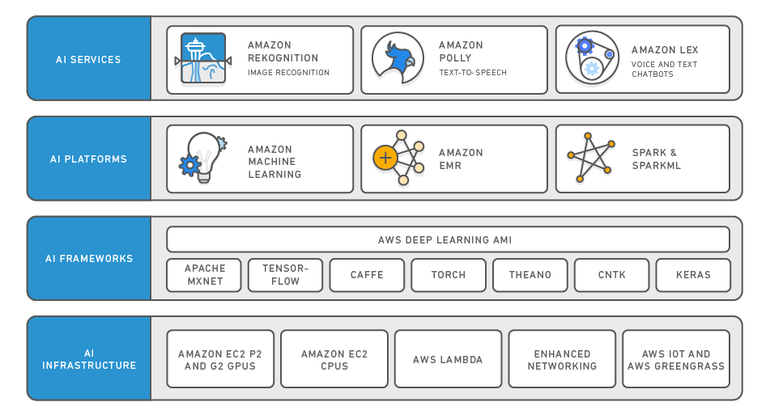Platform Wars (Part II): Amazon AI
Platform Wars (Part II): Amazon AI
- Last Updated: December 2, 2024
Yitaek Hwang
- Last Updated: December 2, 2024



Top AI Companies
In the last edition of Platform Wars, we examined Google’s recent moves to establish its AI products on the cloud. Today, we look at a company whose business model lies on the opposite spectrum of Google’s and has established itself as the King of the Cloud: Amazon.
While Amazon’s acquisition of Whole Foods has pundits buzzing about a possibility of a $1T valuation, the bigger news is how the Everything Store plans to incorporate machine learning and artificial intelligence in every part of its platform to get there.
Yes, the Whole Foods acquisition will transform retail as YouTube and Instagram have changed media when the respective tech giants acquired them. But look no further than Bezos’s annual letter to shareholders to see how important AI is to Amazon:
“Over the past decades, computers have broadly automated tasks that programmers could describe with clear rules and algorithms. Modern machine learning techniques now allow us to do the same for tasks where describing the precise rules is much harder.
At Amazon, we’ve been engaged in the practical application of machine learning for many years now. Some of this work is highly visible: our autonomous Prime Air delivery drones; the Amazon Go convenience store that uses machine vision to eliminate checkout lines; and Alexa, our cloud-based AI assistant. (We still struggle to keep Echo in stock, despite our best efforts. A high-quality problem, but a problem. We’re working on it.)
But much of what we do with machine learning happens beneath the surface. Machine learning drives our algorithms for demand forecasting, product search ranking, product and deals recommendations, merchandising placements, fraud detection, translations, and much more. Though less visible, much of the impact of machine learning will be of this type — quietly but meaningfully improving core operations.
Inside AWS, we’re excited to lower the costs and barriers to machine learning and AI so organizations of all sizes can take advantage of these advanced techniques.”
In summary, Bezos describes three main ways he envisions AI shaping the direction of Amazon: the visible products/systems, underlying infrastructure, and embedded cloud offerings. So without further ado, let’s examine each of these categories.

Image Credit: L2 Inc
Alexa: Amazon’s Operating System
The obvious and the most visible application of AI is Alexa’s natural language processing capabilities. Since the Echo hit the stores, Amazon has not only created a new market (voice-controlled digital assistants in the home), but also established Alexa as the default OS of the home. The latter is significant in part due to the catastrophic failure of Amazon Fire Phones and the subsequent failure to capture the mobile market, but also as a strategic means to broaden its reach.
Amazon, by nature, is a horizontal company that hinges its success on being everywhere. Alexa — and by extension, Amazon’s AI strategy — helps Amazon reach that goal by “achieving scale by being the ubiquitous platform…for AI services” (CBInsights).
I’ve written about the importance of voice and its role as an operating system in the past (see Voice: The Gateway to Ambient Computing and Alexa Dominates at CES 2017), but given Alexa’s continued rise in popularity despite intensified competition from Google Home and Apple Homepod, Alexa’s importance cannot be understated.
Strictly speaking in terms of NLP capabilities, Google probably still holds the edge here given the tremendous work from the Google Brain Team. However, Alexa is still the superior OS. As the preeminent voice platform, Alexa is already in lamps, TVs, DVRs, and fridges with more to come as Sears announced that they are selling Alexa-integrated Kenmore products on Amazon.com.
Perhaps the more significant partnership is one with Microsoft’s Cortana. With this, Alexa is able to tap into the work life of its customers as it now has seamless access to Microsoft’s Office Suite (including Outlook) that many working professionals use.
Even if estimations are correct that Amazon is selling Alexa-enabled hardware at a 10–20% net loss, as long as it can serve as another interface for Amazon’s greater platform, then its AI strategy aligns well with how Amazon built its massive platform in the first place. Also, its strong hold on the digital assistant in the home market makes up for the missed opportunity in the mobile-first era.
AI-as-a-Service
AWS still reigns as the champion in the cloud, generating $12.22 billion versus Azure’s $2.42 bn and GCP’s $0.9 bn (via Quartz). Amazon’s AI platform largely follows the blueprint that has made AWS so successful in the first place: provide low cost infrastructure, allow businesses to build on the platform, and take a skim off the top.
So in recent years, Amazon has built out its AWS ecosystem to encompass voice, image recognition, and other machine learning algorithms through internal research and acquisitions. The goal is to allow developers access to the same backbone that fuels product recommendation, computer vision, and inventory forecasting at Amazon.
Given the ecosystem that AWS already harbors, switching cost alone may encourage businesses to stick with AWS (even though I previously argued that containers allow for near-zero cost switching cost in favor of high performance a la GCP).

Image Credit: Amazon
All four layers that Amazon offers are aimed at making machine learning accessible for anyone to use without necessarily building out top class data science team. AI services provide managed, pre-trained APIs to plug-and-play into your application. EMR and Spark clusters allow customized inference models for those with big data workloads. AWS Deep Learning AMI simplify the deployment process as these come with pre-installed libraries and frameworks that can be easily deployed on an EC2 instance.
Everything Store: Now with AI
Using Alexa to achieve the reach and providing the infrastructure for every level of AI needs on AWS, Amazon is poised to hold down its position as the King of the Cloud. Jeff Bezos knows a thing or two about building a successful top AI Companies, and I would not bet against them even in this age.
Further Reading:
- AMZN + WFM = $1T — No Mercy / No Malice
- 2016 Letter to Shareholders — Amazon
- Alexa: Amazon’s Operating System — Stratechery
- Amazon Strategy Teardown — CBInsights
The Most Comprehensive IoT Newsletter for Enterprises
Showcasing the highest-quality content, resources, news, and insights from the world of the Internet of Things. Subscribe to remain informed and up-to-date.
New Podcast Episode

IoT and AI in 2026
Related Articles


